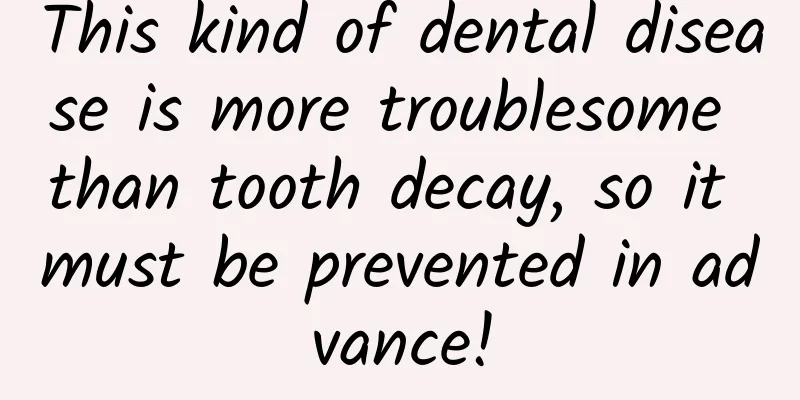This kind of dental disease is more troublesome than tooth decay, so it must be prevented in advance!

|
This is the 3775th article of Da Yi Xiao Hu As we all know, tooth decay is a dental disease that troubles many people, and it always makes people feel that they can't get rid of it. But in fact, simple tooth decay problems (without developing into diseases such as pulpitis) are relatively easy to solve. However, some dental diseases, once they occur, are more difficult to deal with than tooth decay. Today we will talk about one of them - tooth erosion. What do acid-corroded teeth look like? Teeth that have been damaged by acid erosion will undergo two major changes: one is color change; the other is shape change. There are two types of tooth color changes that may be caused by erosion: the first type usually occurs on the incisor edge of the central incisor, which is manifested as a transparent incisor edge, which is the result of thinning of the enamel after corrosion; the second type is a yellowish change on the corroded teeth (see the figure below). This happens because the white, translucent enamel on the outer layer of the tooth is completely corroded, exposing the yellowish dentin on the inner layer. The morphological changes of teeth with acid erosion can be manifested as the tooth surface (such as the labial surface of the front teeth) presenting a wide round concave surface (see the figure below). When the erosion is the most serious, the tooth may even fracture. What exactly causes acid erosion? The answer is simple: acid. But acid can come from many sources, some of which you might not expect! The most well-known source is carbonated beverages, but gastric juice, lemon juice, vinegar, orange juice, beer, coffee and other beverages, some acidic drugs (vitamin C, aspirin, etc.), acid mist or acid anhydride produced by the acid-making industry may also be the culprit of acid erosion. The prerequisite for them to cause acid erosion damage to teeth is that the oral environment can be kept at a pH value of less than 5.5 (the critical pH value for enamel decalcification) and this state can last for a period of time. Why is tooth erosion more difficult to treat than tooth decay? Although erosion is a destructive disease of tooth hard tissue like tooth decay, its treatment is more troublesome than tooth decay. Ordinary tooth decay only requires simple repairs. However, teeth with acid erosion often cannot be repaired. This is because the premise for a successful tooth filling is that the healthy tooth tissue and the filling material after the filling can both exist stably and support each other. Because the lesion area of tooth decay is usually limited in scope and has a certain depth, the shape of the tooth cavity after trimming can easily meet the requirements of tooth filling; however, it is different for teeth with acid erosion. As mentioned above, the shape of its defective part is often wide in scope and shallow in depth, so the filling is often not strong. Many cases of acid erosion can only be treated with restorative technology (such as full crown). To prevent acid erosion, do these things! Simple treatment cannot fundamentally solve acid erosion. As long as the cause persists, the damage will persist. Therefore, to prevent acid erosion, we must start with the cause and minimize the damage caused by acid. Acid erosion caused by gastric juice is often related to anorexia, gastroesophageal reflux and other diseases, so the above diseases should be treated as soon as possible; frequent or long-term drinking of carbonated beverages, lemon juice, orange juice, beer, coffee and other beverages, and even liking to hold these beverages in the mouth, are bad eating habits and should be avoided as much as possible. It is better to drink warm boiled water as a daily drink, which is good for dental health and overall health. In certain disease states, if you need to take acidic medications or medications that may cause insufficient saliva secretion, you should pay special attention to preventing erosion. In daily care, on the one hand, we should pay attention to the use of fluoride toothpaste, fluoride mouthwash, etc. to enhance the acid resistance of the hard tissue of the teeth; on the other hand, we should also pay attention to the correct manual brushing operation with a soft-bristled toothbrush to avoid aggravating the damage of acid to the teeth. Author: Shanghai Health and Health Development Research Center rich |
<<: Do you take this kind of hand numbness seriously? ——The trouble of carpal tunnel syndrome
>>: A brief discussion on Pneumocystis carinii pneumonia
Recommend
Paris polyphylla pollen is very effective and is a natural anti-cancer agent
Paris polyphylla pollen is an effective anti-canc...
The safest antibiotics for pregnant women
Antibiotics are a type of secondary metabolic sub...
Warts at vaginal opening
If some warty growths grow at the vaginal opening...
Heavy bleeding the next day after eating mifepristone
Mifepristone is an anti-progestin drug, mainly us...
What causes dark skin during pregnancy?
After pregnancy, there will always be various pre...
[Medical Q&A] Can a suspected fracture be confirmed by taking an X-ray?
Planner: Chinese Medical Association Reviewer: Sh...
What are the effects of rhinitis in pregnant women on the fetus?
During pregnancy, most of the body becomes very f...
Can women with polycystic ovary syndrome have sex?
Some female friends who have polycystic ovary syn...
How to treat tinnitus during menopause
In our lives, many people are particularly prone ...
benjaminmayo: Twitter's own client has a market share of 77%
How many people are using Twitter's own app? ...
What are the dangers of ovarian cysts?
I believe that in daily life, many female friends...
What to do if estrogen is low
Ovulation induction means promoting the release o...
What month is the spring tea season? When is the spring tea harvested?
The temperature during the Spring Festival is mod...
Belly enlargement after laparoscopic surgery
An enlarged belly after laparoscopic surgery may ...
Reasons for delayed menstruation for 15 days
When it comes to the issue of delayed menstruatio...









